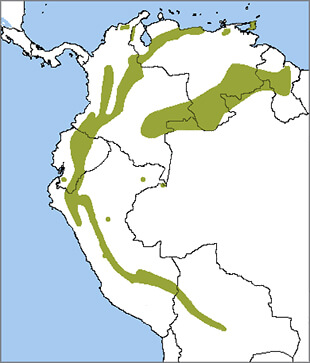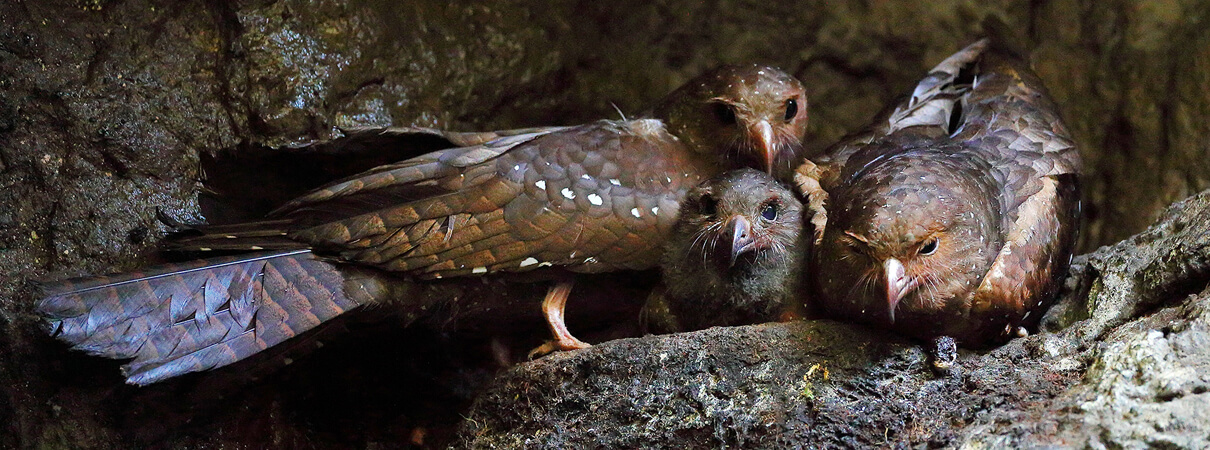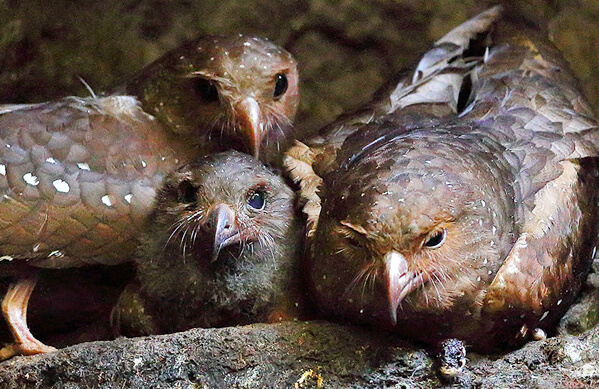 The Oilbird is an oddity. It's a nocturnal, fruit-eating bird that uses echolocation, much like a bat, to navigate. It nests inside caves in noisy colonies, where its raspy wails give it the Spanish nickname guácharo, "one who whines or laments.” Oilbirds are in their own family but are part of a larger group of night birds including Eastern Whip-poor-will, Chuck-will's-widow, and Common Potoo.
The Oilbird is an oddity. It's a nocturnal, fruit-eating bird that uses echolocation, much like a bat, to navigate. It nests inside caves in noisy colonies, where its raspy wails give it the Spanish nickname guácharo, "one who whines or laments.” Oilbirds are in their own family but are part of a larger group of night birds including Eastern Whip-poor-will, Chuck-will's-widow, and Common Potoo.
The Oilbird is named for the young birds, which are so fat that indigenous people and early settlers once collected and rendered them down to oil for lighting and cooking.
Although the Oilbird remains common throughout its range, its forest habitats are not always effectively protected. Like the Harpy Eagle, Golden-headed Quetzal, and Military Macaw, it is most threatened by habitat loss.
Oilbirds spend their days in darkness, resting deep inside caves and sometimes within thick tree canopies. They awake just before dusk and leave their roosts to feed, using keen nocturnal vision and sense of smell to locate fruit, which they pluck from trees while hovering.
Sign up for ABC's eNews to learn how you can help protect birds
(Audio: Calls and echolocation clicks by birds in Guácharo Cave National Park, Venezuela. Audio by Nick Athanas, XC8218. Accessible at www.xeno-canto.org/8218.)
Cave Creatures
Oilbirds are gregarious, nesting in colonies of up to thousands of birds. They build their mounded nests of regurgitated fruit and their own droppings high on cave ledges, where the female lays two to four eggs. Parents stuff the newly hatched chicks with rich fruits, and the young birds quickly become fluffy and fat, reaching weights of almost twice as much as their parents before they fledge.
Far-flying Frugivore
Unlike the nightjars they resemble, which eat insects, the Oilbird is a frugivore (fruit-eater), favoring oily, fatty wax palm and avocado fruits, which they pluck from trees with their formidable-looking hooked beaks, then swallow whole. Oilbirds may range up to 150 miles in a single night as they forage.
Like Bearded Bellbird and Banded Cotinga, Oilbirds are responsible for establishing new fruit trees far and wide as they excrete the seeds they swallow, often at a considerable distance from the host tree. Miniature forests of saplings grow on the floors of oilbird caves thanks the rain of seeds deposited by nestlings and adults inside.

Oilbird family by Greg Homel, Natural Elements Productions
Conservation across Countries
Fortunately, Oilbirds are no longer widely hunted for food and fat, and may be found in and around several ABC-supported reserves. Visitors crossing the narrow Quiscarrumi bridge on the way to Peru's Abra Patricia Reserve can view a colony of Oilbirds roosting in a deep crevasse, which they share with White-eyed Parakeets. The reserve was established by our partner ECOAN with ABC support.
ECOAN has worked with the local community to raise awareness of the Oilbirds, and interpretive signs now highlight the roost at the bridge. "Seeing and listening to the Oilbirds of Quiscarrumi is a great way to begin or end a northern Peru birding trip," says Dan Lebbin, Vice President for Threatened Species at ABC.
Oilbirds also inhabit several Ecuadorian reserves managed by our partner Fundación Jocotoco. The birds can be seen at Tapichalaca, where they share the forests with Jocotoco Antpitta and Golden-plumed Parakeet, and at Buenaventura, which protects populations of El Oro Parakeet and Long-wattled Umbrellabird.
This species has also been noted at the El Dorado Reserve in Colombia, home to endemic birds such as Santa Marta Parakeet and Santa Marta Bush-Tyrant.
Interested in visiting any of these places? See Conservation Birding, where your travel dollars will support bird conservation in the Americas.
Donate to support ABC's conservation mission!



















































